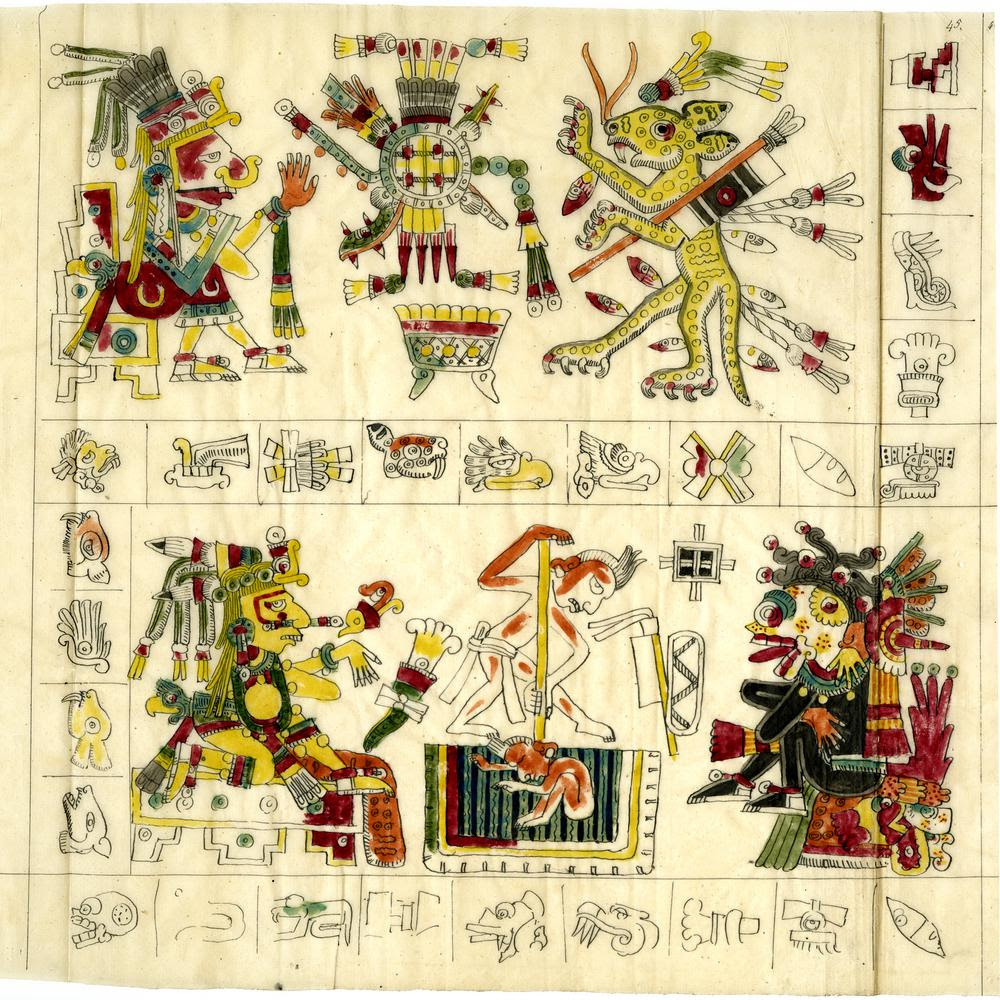.

Page from Codex Borgia, pre-Columbian: author unknown, facsimile (British Museum)
At a dark portal between cosmic realms
A wizard found himself stood up by the Morning Star --
Evening his element as the Rain God's is water.
She who has the power of giving flowers
Promises everything is alive
As long as the night sky stays fresh and new.
"Only a moment here on earth.
It is untrue that we have come
To live here on earth."
On a golden dais laid over the broken stones
In the declining shadow
Between the rising of the Morning Star
And the setting of the Evening Star
The palace of the Smoking Mirror is built.
The second temple is not like the first.

Page from Codex Borgia, pre-Columbian: author unknown, facsimile (British Museum)

Page from Codex Borgia, pre-Columbian: author unknown, facsimile (British Museum)

Page from Codex Borgia, pre-Columbian: author unknown, facsimile (British Museum)

Page from Codex Borgia, pre-Columbian: author unknown, facsimile (British Museum)

Page from Codex Borgia, pre-Columbian: author unknown, facsimile (British Museum)

Page from Codex Borgia, pre-Columbian: author unknown, facsimile (British Museum)

Page from Codex Borgia, pre-Columbian: author unknown, facsimile (British Museum)

Page from Codex Borgia, pre-Columbian: author unknown, facsimile (British Museum)

Page from Codex Borgia, pre-Columbian: author unknown, facsimile (British Museum)


Page from Codex Borgia, pre-Columbian: author unknown, facsimile (British Museum)

Page from Codex Borgia, pre-Columbian: author unknown, facsimile (British Museum)


Page from Codex Borgia, pre-Columbian: author unknown, facsimile (British Museum)
Codex
Borgia (facsimile): British Museum. Drawn by Agostino Aglio.
Representation of Aztec culture; pre-Columbian; date of original c.
1500, made in Mexico; facsimile painted in Vatican City, 1825-1831;
drawn on paper, height 25.8 metres (screenfold); width 990 centimetres.
The tracings of the codex are on two screenfolds. The tracing was commissioned by Lord Kingsborough and made by
Aglio in the years 1825-31. It is published in vol. 3 of Kingsborough's
nine volume work “Antiquities of Mexico ...”
Codex Borgia is preserved in the Apostolic library at the
Vatican in Rome, Italy. It was constructed of animal
hide and covered with a white plaster-like foundation
upon which the figures were painted. It was folded so that
it could either be stored compactly or opened to reveal
all of the pages of one side. Codex Borgia features a page
by page portrayal of the various divisions of the sacred
260 day calendar or tonalpohualli (toe-nall-po-wha-lee). Diviners used the calendar to
foretell the future of children born under each of the 260
day signs. Codex Borgia was used by palace diviners, mid-wives, and curers as a
means of invoking the prophecies of the gods.


Screenfold pages from Codex Borgia: image by Princeton University Art Museum

Mictlantecuhtli and Quetzalcoatl Ehecatl -- Codex Borgia. Aztec gods of death and wind. (Work in progress -- 1): image by Gwendal Uguen, 28 May 2012

Mictlantecuhtli and Quetzalcoatl Ehecatl -- Codex Borgia. Aztec gods of death and wind. (Work in progress -- 2): image by Gwendal Uguen, 28 May 2012



2 comments:
Another mystery! Beautiful.
Thanks, Nin.
Ah, those Aztecs -- great with the comics... though you might not want to invite them over for a dramatic reconstruction of the action.
Post a Comment